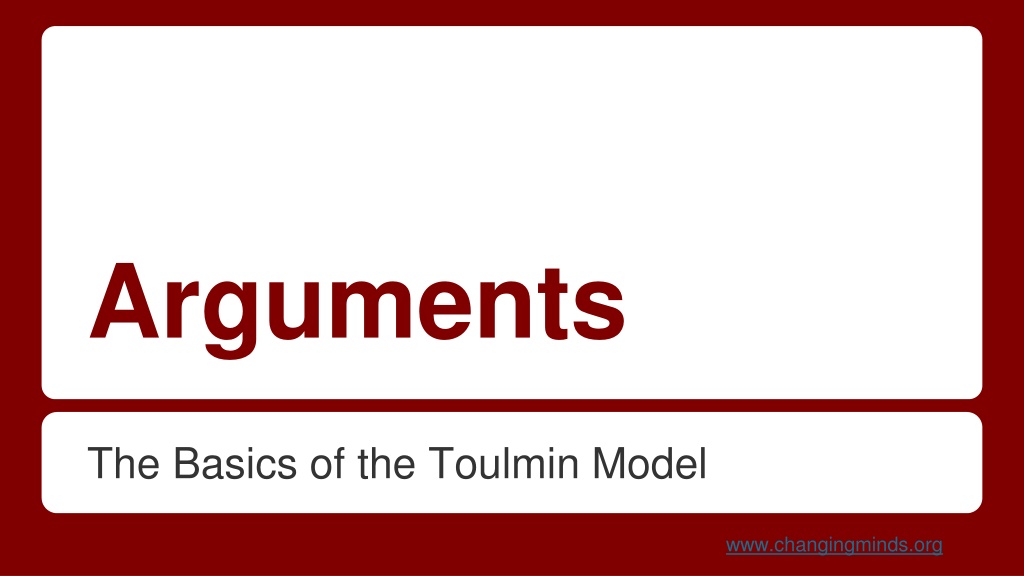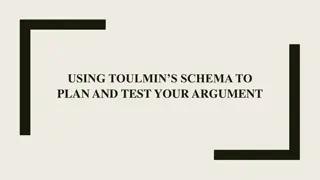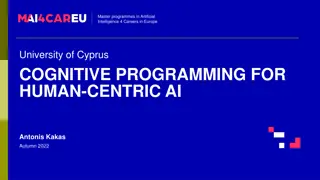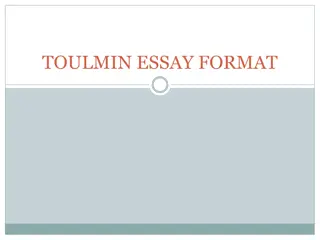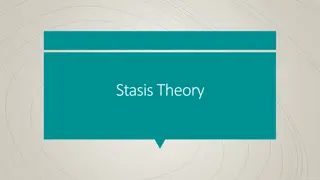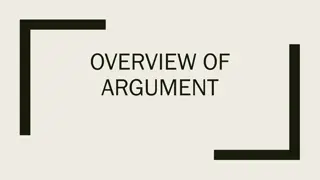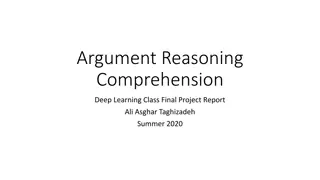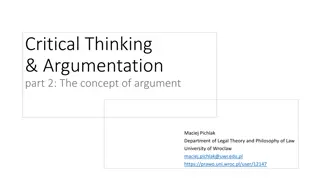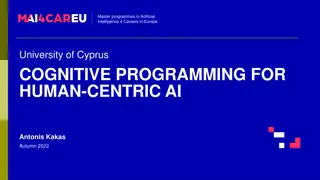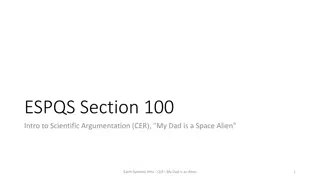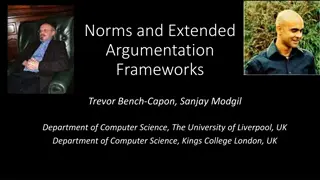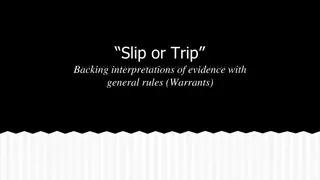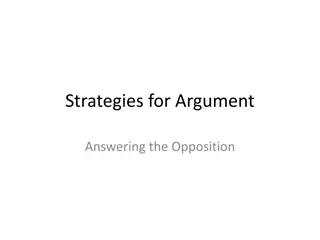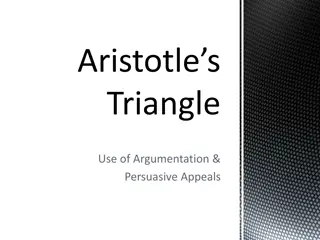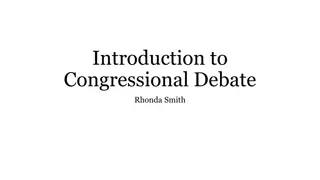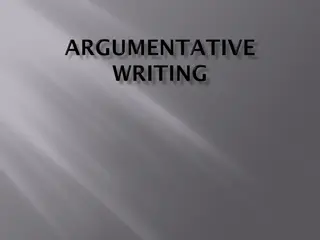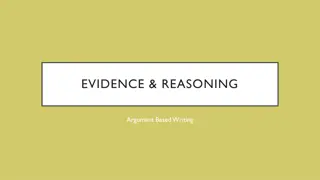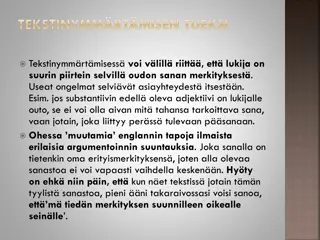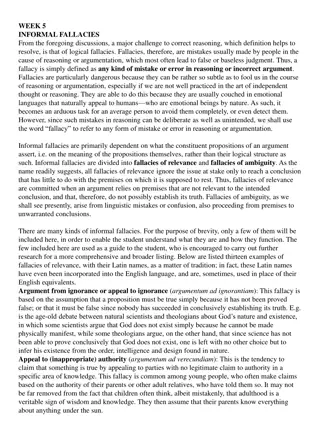Understanding the Toulmin Model for Effective Argumentation
The Toulmin Model provides a structured approach to crafting and evaluating arguments, consisting of key components like claims, grounds/data, and warrants. It emphasizes the importance of using evidence and reasoning to support claims effectively. By understanding this model, one can enhance the persuasiveness and validity of their arguments. The provided content illustrates the essential elements of the Toulmin Model and demonstrates its application in forming compelling arguments.
Download Presentation

Please find below an Image/Link to download the presentation.
The content on the website is provided AS IS for your information and personal use only. It may not be sold, licensed, or shared on other websites without obtaining consent from the author. Download presentation by click this link. If you encounter any issues during the download, it is possible that the publisher has removed the file from their server.
E N D
Presentation Transcript
Arguments The Basics of the Toulmin Model www.changingminds.org
What is the Toulmin Model? A basic formula for forming arguments, the Toulmin model is great for creating your own argument, or for evaluating the argument of another.
The Basic Components Claim Data (Grounds) Warrant
Claims A claim is a statement that you are asking the other person to accept. This includes information you are asking them to accept as true or actions you want them to accept and enact. Example: Schools should be required to start school no later than eight am.
Grounds/Data The grounds (or data) is the basis of real persuasion and is made up of data and hard facts, plus the reasoning behind the claim. It is the 'truth' on which the claim is based. Grounds may also include proof of expertise and the basic premises on which the rest of the argument is built. Example: Recent studies have revealed that many teens are not getting enough sleep. According to the National Sleep Foundation, teens require a minimum of eight to ten hours a night.
Warrant A warrant links data and other grounds to a claim, legitimizing the claim by showing the grounds to be relevant. The warrant may be explicit or unspoken and implicit. It answers the question 'Why does that data mean your claim is true?' Example: Starting school later, would assure that students are able to get the necessary hours of sleep needed to function at their optimal levels at school.
Put it together Schools should be required to start school no later than eight am. Recent studies have revealed that many teens are not getting enough sleep and according to the National Sleep Foundation, teens require a minimum of eight to ten hours a night. Starting school later, would assure that students are able to get the necessary hours of sleep needed to function at their optimal levels at school.
Practice: Read the passage to identify Claim Grounds/Data Warrant Counterclaim
CLAIM GROUNDS/EVIDENCE WARRANT With the alarming rise in obesity rates among Americans in the past few decades, numerous debates have arisen over how (or if) public policy should be changed to help improve this trend. One promising strategy, already adopted by seven states, has been to try and deter consumers from purchasing unhealthy foods through a tax on soda or sugary drinks and junk food (Lohman, 2002). These taxes address the issue that Americans today are consuming almost 20% more calories than they did in the early 1980 s, and those calories are coming from increasingly less-healthy sources, mainly high-fat and high-sugar processed foods (USDA, 2002). Furthermore, processed foods and drinks are increasingly more affordable than the fruits, vegetables, and whole grains needed to sustain a healthy diet (Marsh, 2011). Assuming that cost is a more pertinent factor of food choice than personal taste, increasing the price of soda and junk food through taxes, while using that revenue to subsidize unprocessed fruits and vegetables would entice consumers to choose healthier products as they become more affordable than their unhealthy counterparts.
Toulmin Model Backing Qualifiers Counterclaims & Rebuttal
Backing The backing (or support) for an argument gives additional support to the warrant by answering different questions. Example: There is evidence to suggest that cost, more so than preference, influences purchasing choices. A year after New York increased cigarette taxes from $1.25 to $2.75, smoking rates dropped by 12% to a historic low (Harutyunyan, 2009).
Qualifiers The qualifier (or modal qualifier) indicates the strength of the leap from the data to the warrant and may limit how universally the claim applies. They include words such as 'most', 'usually', 'always' or 'sometimes'. Arguments may hence range from strong assertions to generally quite floppy with vague and often rather uncertain kinds of statement. Example: However, if precautions are taken to ensure equal access to healthy food among all citizens, then using the carrot of subsidized healthy food and nutrition education along with the stick of a food tax, the typical American diet can-- and should-- be changed for the better.
Counterclaims/Rebuttals Despite the careful construction of the argument, there may still be counter-arguments that can be used. These may be rebutted either through a continued dialogue, or by pre-empting the counter-argument by giving the rebuttal during the initial presentation of the argument. Example: Although some might argue that smoking is more of a lifestyle choice than eating, it is rather the choice of what foods to eat which will hopefully be affected in the long run. Additionally, this tax might hurt those in areas with little access to fresh produce and whole grains, such as in low- income urban areas; therefore the junk food tax would only work if healthy food choices are made not only affordable but easily available to low-income consumers through the use of subsidies (Marsh, 2011). However, if precautions are taken to
